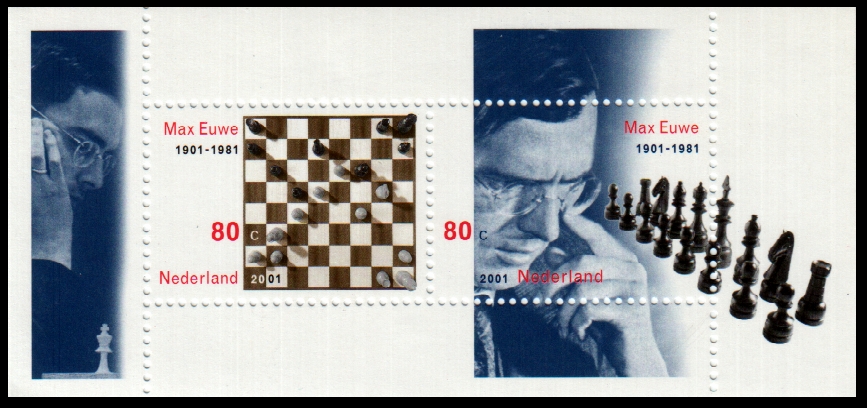 deutsche Version
deutsche Version| Manfred Börgens Mathematics on stamps |
stamp list previous stamp next stamp |
main page |
 deutsche Version deutsche Version |

Chess and Mathematics Part 1 Part 2
Max Euwe (1901 - 1981)
The Dutchman Euwe's first name was Machgielis but he is better known as Max. He studied mathematics at the University of Amsterdam and obtained a Ph.D. degree in 1926. Until 1940, he worked as a high school teacher. After the war, Euwe started research in the young field of informatics which at that time was regarded as a branch of mathematics. In 1954, Euwe became professor for cybernetics, and in 1959, director of the Dutch research center for automatic data processing. In 1964, he got a chair for informatics, first at the University of Rotterdam, later at the University of Tilburg.
Max Euwe became famous as chess world champion from 1935 to 1937. The 1935 match with title holder Alexander Alekhine took place in several Dutch cities and was one of the longest in the history of chess. Euwe won 9 games, Alekhine 8 games; 13 games were drawn. The left stamp above shows the position of the pieces in the final game. In 1937, Alekhine won his title back.
There is a connection of the region where I live to Max Euwe. 70 years ago, in 1937, the spa town of Bad Nauheim in Hesse, Germany staged an international tournament with Euwe, Alekhine, Bogoliubov and Saemisch. This tournament (which was continued in Stuttgart and Garmisch) was won by Euwe.
Euwe was FIDE president from 1970 to 1978. During his presidency, the title match between Fischer and Spassky took place in Reykjavik. As it is well known, the negotiations between Fischer, Spassky and the FIDE were difficult and Euwe's diplomatic skills were very helpful before and during the match.
Euwe provided an interesting link between mathematics and chess. For that reason, I singled him out for part 1 of "Chess and Mathematics" (part 2 portrays six other mathematicians who became famous in chess and who were honoured with stamps).
Now to the problem in which Euwe took interest as a mathematician as well as a chess master. Is chess a finite game? The FIDE rules now in use guarantee the finiteness - at least in a game theoretic sense. There is only one small loophole in the rules: There are (theoretically) drawn games which will go on forever because neither player claims the draw (in that case the referee has no authority to finish the game). But back in the 1920s, different rules were discussed. Here is one of them:
A chess game is drawn if the same sequence of moves - with all pieces in exactly the same positions -
is repeated three times consecutively.
This rule is called by Euwe the "German rule" and should not be confused with another rule currently in use: A game is drawn if the same position of the pieces occurs the third time.
In the German rule, the length of the sequence is insignificant. The rule may have seemed to make sense because there was evidence for repeated move sequences from numerous very long games in which neither player would resign or agree in a draw. But the rule does not make chess a finite game, and Euwe proved this.
At this point mathematics enter. In a 1929 article, Euwe defined a sequence d(n) of 0s and 1s recursively:
d(0) = 0 d(2k+i) = d(i)*
The asterisk means x* = 1 - x (exchange of 0 and 1). The sequence d(n) is built by definition in blocks of 2k figures:
0
0 1
01 10
0110 1001
01101001 10010110
...
It should be mentioned that there is also a direct, non-recursive definition of d(n) :
d(n) = q(n2) mod 2
n2 is the number n in binary form, q is the sum of the digits. So d(n) = 0 if n2 contains an even number of 1s , and d(n) = 1 if the number of 1s in n2 is odd.
This sequence is analyzed on a problem page of this website.
Max Euwe was not the first mathematician who used the sequence d(n) . It seems to have been defined several times independently. E. Prouhet, A. Thue, H.C.M. Morse and G.A. Hedlund applied it in different mathematical fields (cf. Thue-Morse sequence).
Euwe proved that no part of the sequence is repeated three times consecutively. He then proceeded to the application of his proof to the German rule: It is easy to design a sequence of chess moves denoted by "0" and another sequence denoted by "1" which both at their end leave the pieces unchanged and in their previous positions, and which consequently can be combined to an infinite sequence. I will give an example for the start position of chess games. Only knights are involved:
0 : b1 - c3 b8 - c6 c3 - b1 c6 - b8
1 : g1 - f3 g8 - f6 f3 - g1 f6 - g8
Combining these moves according to Euwe's sequence obviously leads to an infinite game if the German rule holds (and no other termination rules apply) because threefold repetitions do not occur. Naturally, more realistic situations in a chess game - particularly near the end of the game - can be constructed.